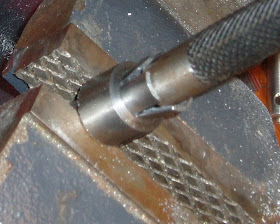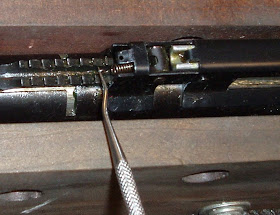
The forward end of the piston has a cupped washer that retains the piston seal. It's held to the piston body with an M5 phillips head bolt.

I was a bit surprised that it was not much more than finger tight. I replaced the phillips head with a low profile torx fastener. The threading is metric: M5 x 0.8mm.

Applied a medium strength thread locker and torqued it down with a T25 torx wrench. I figured the torx would allow more torque with little chance of damaging the head of the fastener. Deep inside the gun is about the last place you'd want something to come loose.

The original spring is up top. Dimensions of the original BAM spring: 8.563" OAL. 0.1215" diameter wire, 0.725" OD, 0.482" ID. The small amount of cant didn't particularly bother me. The deep rust pits did. I hit the parts box and found a likely candidate. No idea why I didn't label it, but it's probably the mainspring from a Crosman/Remington Summit. It's obviously too long, so I cut the spring down leaving it 2 coils longer than the stock spring. It's most likely still too long and will need further shortening. Deal with it a bit later. The new spring measures: 0.124" wire diameter, 0.733" OD, 0.485" ID. As of right now, it's 8.888" OAL.

Turned my attention to making a new spring guide. Kinda amazed that the factory guide was actually a tight fit to the factory spring. It was quite a bit too short though and that likely caused the cant in the original spring. I cut a 0.500" steel tube down to about 4" for a new guide.

Chucked the tube into the Taig and set up the steady rest. Opened up the ID of the tube to 0.400" to allow the piston rod to pass through. The piston rod is 0.391" in diameter.

I turned the OD of the tube to 0.481". A slip fit for the new mainspring. Here, I've just finished the last pass with a fine file. Normally, I'd have gone for a tighter fit to the spring, but my experience with that IZH-61 makes me leery of tight fitting guides on low-powered guns.

Cut about 0.75" off. I'm just winging the numbers for the guide length. It's easy enough to shorten later if I made it too long.

Slotted the end of the spring guide.

Turned 90 degrees and slotted again to the same depth.

Made a bushing to fit over the guide.

Like so.

The bushing acts as a stop at the base of the slots.

The end of a drift gets things started.

Belling the end open.

Getting there...

And peeled it open like a flower.

Hammered the tabs flat and trimmed them down in length.

Old guide on the left. The original sheet metal guide diameter varies from 0.465 to 0.482". It's 1.827" OAL.
My new guide on the right with a washer added. The tabs act as a stop to retain the washer. The older Weihrauch spring guides in the Beeman R-series guns look similar to this.

Set all that spring stuff aside for a few minutes and grabbed the cocking lever and some heat shrink tubing.

Some of that vinyl tool handle dip would also work well for this.

Three layers of heat shrink later. This'll be more comfortable and non-slip. I'm sure I've seen something similar. Maybe Steve at Archer Airguns?

Dropped the cocking lever into a vise and hammered out the latch pin.

The latch was removed and the angle cleaned up and polished. In theory, it should snap closed a bit easier.

I'm working all over the place on this thing. The rear sight was a mess. It was loose, it shifted when the gun fired... Really a challenge to hit the same thing twice. Actually, it was a challenge to hit anything once. The sight base was spot welded to the receiver tube in four semi-random locations. I center-punched what looked like the middle of each spot weld then center drilled each.

Followed up with a 1/8" end mill. I set the depth stop to just pass through the sight base.

A sharp smack popped the base off. The bare spots on the receiver will be cleaned up a bit later. I keep telling myself that it's still not too late to just throw it all in the trash.
Still more to come later. Unless I come to my senses.





































